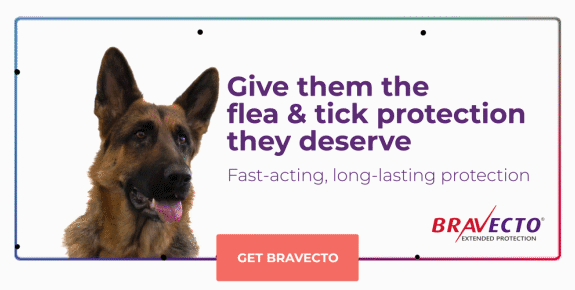Adopting a Rescue Dog or Cat

History of SPCAs
The first animal rescue organisation began in England in 1824. It was called the Society for the Prevention of Cruelty to Animals, and came about primarily to prevent the abuse of carriage horses, when there were no cars on the roads. Many of these horses were subjected to harsh and inhumane treatment, including being compelled to work in freezing conditions with little food, water or rest. The owners were only interested in making money and treated the horses like machines, driving them until they got sick, collapsed and, in many cases, died.
The first SPCA helped to have laws passed which regulated the treatment of these horses. Its success led to including other animals which benefitted from these laws. In 1866, the first American SPCA started in New York. Now, there are SPCAs all over the world, including of course, South Africa. They take in rescued dogs and try to re-home them. Unfortunately, there are more animals than homes. The SPCAs do wonderful work but are always short of funds. There are also many other rescue centres, which are NGOs and rely heavily on donations. Many of these centres have ‘shops’ where they raise funds by selling donated goods.
PLEASE SUPPORT YOUR SPCA OR LOCAL ANIMAL RESCUE CENTRE WITH DONATIONS, EVEN IF YOU CAN’T ADOPT A PET.
You’re thinking of getting a dog or a cat…
So, you’re thinking of adding to your family by getting a dog or a cat. You may have thought about what breed you’d like, considering your lifestyle and your circumstances. Let’s follow this process with a real, genuine person:
“Hi. My name is Sharon. I am married with two children aged 2 and 6. Just lately, my husband, Jim and I have been talking about getting a dog. We’re an animal-loving family, so this seems like a natural step. I’ve always wanted a Yorkie and Jim has his mind set on a German Shepherd. We would also love to get a rescue dog though, but we’re not sure whether or not there might be problems.
For example: How do you know that a tiny mixed-breed puppy won’t grow into Dogzilla? Won’t there be health problems? We’ve also heard that rescue dogs can have psychological problems, if they might have been abused? In other words, how do you know what you’re getting?”
Hi Sharon, you’ve come to the right place for answers to your questions. We’ve done some research and we feel that this will assist you in making a decision about adopting a dog.
Why adopt a rescue dog or cat?

SO many reasons, we hardly know where to begin!
- They are lovely, lovely dogs/cats!
- First and foremost adopting an orphan animal benefits the animal and benefits you.
- You’ll be saving a life. Many rescue shelters do not euthanize animals, but sadly, some have no choice, as the fact is that there are too many animals and too few people wanting to adopt them.
- You will be opening up another place in the shelter for another dog, cat or other animal.
- You will be saving money. Let’s face it, particularly during the Covid-19 pandemic, this is a concern for most of us. If you buy a pedigree puppy or kitten from a breeder, depending on many factors, you will pay from around R2,000 up to around R30,000 plus! Then you’ll have to pay for vaccinations (the breeder will usually have only done one set of vaccinations), which can cost up to R1,400; neutering or spaying can cost thousands of Rands and microchipping costs around R400.
As with rescue animals, no guarantee comes with pedigree pets. The harsh truth is that any animal can get sick, whether a R10,000 imported Bull Mastiff or a cross-breed like Big Bruiser. You cannot get your money back, in either case.
This brings the average cost of adopting a pedigree dog to about R5,500, for a puppy costing about R2,000.
For a rescue puppy you’ll be paying around R800 for a dog, R600 for a cat and around R900 for a puppy. That’s it! Some vaccinations (more may be required), spaying/neutering and often microchipping, are included in the price.
- You shouldn’t assume that lots of animals in shelters have health or behavioural problems. Many pets end up in shelters, not because there is anything wrong with them, but because of human problems, such as the inability to cope with the pet; moving house; divorce or because they simply cannot afford to feed the pet. Many people in this country can hardly afford to feed their families, never mind a pet. Rescue centres have been overwhelmed in South Africa, and around the world, because of the Covid pandemic. There are also, sadly, those people who take their animals to shelters simply because their pet has become ‘inconvenient’. Sadly, it happens.
- If you are set on a pedigree puppy or kitten, many shelters sometimes have these pets available for adoption. There are also rescue centres who take in a particular breed of dog or cat, for example S.A. Yorkie Rescue. You will find these centres on the web.
- You will be playing your part in stopping puppy mills, which are basically factory breeding centres. These are usually the puppies or kittens mainly sold in pet shops and online. The conditions are often dreadful with no proper medical care and often with sick and psychologically-damaged animals. They usually practise over-breeding with a mother dog or cat, who is bred over and over again. They usually euthanize animals which are not profitable. If you are buying a pedigree animal, please, please buy from a reputable breeder.
- Be sure that you really want this pet and ask yourself if you can afford to feed him/her and bear the cost of veterinary bills, before you adopt him/her. This is the reality: Do you have the means, time and space to give this animal a good life?
- You will have the satisfaction of saving a life by giving an unwanted animal a second chance and you will have a wonderful animal in your family. Some people with rescue pets say that they get the impression that their pet is grateful to their human mom or dad for saving them.
Do you have any tips for me, once I adopt a rescue pet?
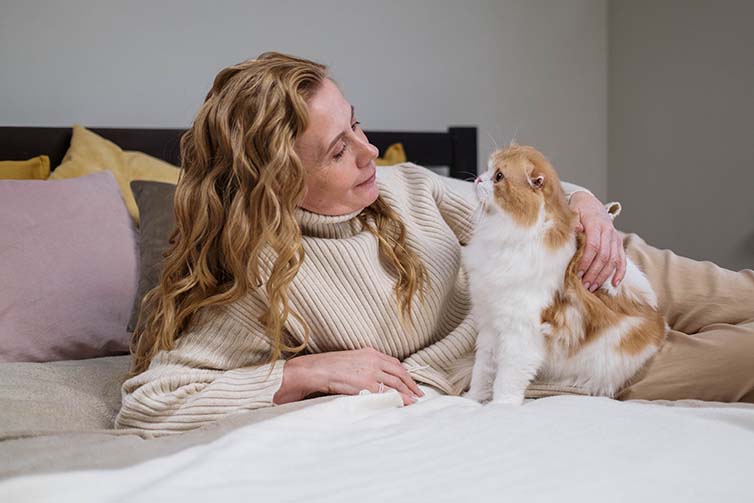
Absolutely! In fact, there are a couple of things you can do before bringing your pet home.
Before adoption.
The first few days are very important to ensure that your rescue doggy or kitty settles in as soon as possible, for his/her sake and yours. Remember that a rescue animal may be perfectly healthy, but you have to take into account the possibility that the animal may be dealing with some past trauma. Everything and everyone in your home is new to your new furry friend, so kindness and patience, in spades, are key to your pet settling in to your home and getting to know you and your family. He/she may not have known much kindness in his/her life, so take it easy and REMAIN CALM AT ALL TIMES!
The rescue centre will provide you with some idea of your pet’s background and temperament etc. Ask them lots of questions. Ask yourself whether or not this is really the furry friend that you want and can deal with.
Check your home for any potential hazards, like poisonous plants, detergents and bottles of bleach , trash, any sharp objects, access to swimming pool, and so on. The best way to ensure that your new pet does not come in contact with these items is to limit access. Put any potentially hazardous items out-of-reach. This is, of course, harder if you are adopting a kitty, but most stuff can be locked away. Click here for more on making your home safe for your cat.
Speaking of kitties, make sure that you provide places to climb and to feel safe and secure for kitty in your home. You should restrict him/her to a small room/area for up to 10 days to allow your new friend to acclimatise, before allowing him/her to roam.
Security is very important. Obviously you will ensure that your new puppy cannot get out of your garden. You could cordon-off a small area but you will still have to keep a close eye on him/her for some weeks.
You will need to go shopping before little Cuddles or Big Bruiser arrives. For a dog, you’ll need a crate, some dog-proof toys, treats (very useful for training), a nice warm bed, blankets, a collar and lead and some feeding/water-bowls. You might also need some ‘puppy pads’, depending on how you’ve decided to house-train your doggie.
For a kitty, you’ll need some scratching posts (the other option is your furniture), a warm bed, and some feeding/water-bowls. You may also need a litter-tray and litter, especially if kitty doesn’t have access to a garden.
You should ask the rescue shelter what kind of food your new friend has been used to. Try to keep on feeding this food and if you introduce a new food after a few weeks, do it gradually: decreasing the old food and increasing the new. This applies to puppies/kittens and adult dogs/cats. If you make a sudden change of food, you run the risk of your new furry getting sick. The best thing to do, is to speak to your vet on the first visit.
If you don’t have a vet, then ask around and get some recommendations.
After adoption
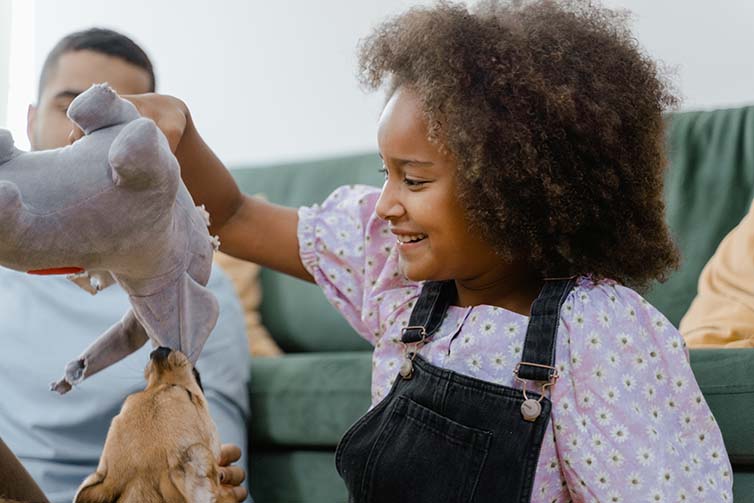
Remember – the key words are calmness, patience and kindness.
The First Day
Obviously, everyone will be very excited about the new addition to the family. Please ask your children, who will be beside themselves with joy, to be as calm as possible. Their new friend will be very frightened and overwhelmed initially. Limit contact at first and limit space. Do not allow puppy/kitty to roam around the whole house. A crate or cat-box will be useful in many cases, so that the new arrival feels safe and secure. Above all, avoid fussing and too much kissing and hugging (of your pet, not each other!). If possible, start a routine from Day 1. There should be times for feeding, potty training, walking and sleeping. This will make your new arrival feel safe and secure.
Building relationships
If you have an adult dog or cat, it will take some time to build up trust in you, your partner and your children. You will need to explain to your children that they must be gentle with little Cuddles or Big Bruiser, and that if they inadvertently hurt their new pet, they may get bitten or scratched. Show them how to pat, hug and carry. This new relationship will build new bonds and teach them wonderful qualities like empathy and kindness. Encourage them, if they are old enough, to take responsibility for their new friend, perhaps by feeding him/her. They can certainly play with their new doggie or kitty, as long as this doesn’t get too hectic or rough.
If Bruiser has a job, like being largely a guard dog, he should still be allowed to spend time indoors. All dogs, and cats, like to feel the security of being part of the family, especially rescue animals.
Training and learning
You should try to use ‘positive reinforcement’ at all times. This is a method taken from behavioural psychology, and basically it means that no animal (or human) will learn by your shouting, smacking or punishing when he/she does something ‘wrong’. We, and all animals, need to be encouraged and rewarded when we do something good. If animals or children do something wrong, you should ignore it. (We never said that this would be easy!) There will be potty ‘accidents’. This can happen with adult pets too, depending on their background. The rescue centre should tell you if Big Bruiser, who is 8 years old, is house-trained. If not, it could take some time for Bruiser to ‘get the message’, but he will get there, with patience. Older dogs CAN be trained; it just takes longer.
There must, of course, be boundaries for all animals and children in your house.
A visit to the vet
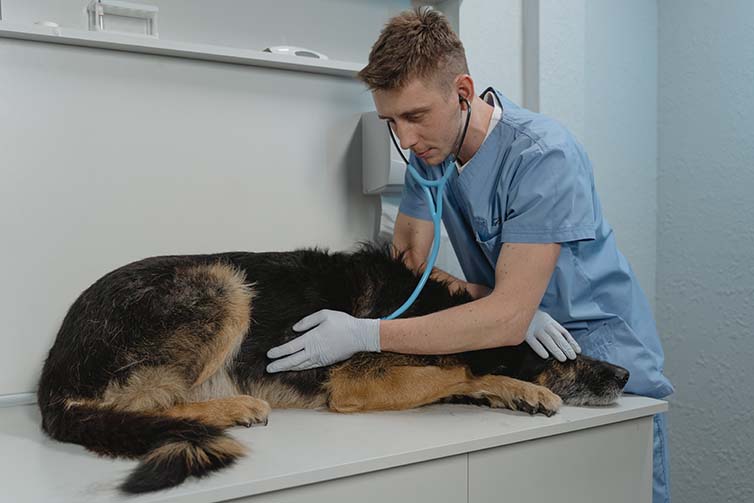
Your new friend will probably have been seen by a vet in the rescue centre. However, it’s important to introduce yourself and Cuddles to your chosen vet, who will probably do a thorough check and perhaps do some blood samples. If you are aware of any background details from the shelter, then tell the vet.
Your vet may advise you to give your new buddy a tick and flea treatment, and a de-worming pill. Many vets are recommending Bravecto® tick and flea treatments as they last up to 12 weeks or 3 months (depending on which product you choose), stopping the tick and flea lifecycle.
Behaviour Problems
There will probably be no behaviour problems with your new buddy, but if you see any signs of destructive behaviour like aggression, excessive barking, whining, chewing or a house-trained dog weeing in the house, then you should consult your vet. Such behaviours are usually the result of stress. He may give you some medication (for the DOG!) or refer you to an animal behaviour therapist. On the other hand, such behaviours usually go away of their own accord, once Cuddles or Bruiser is settled in.
Other cats and dogs
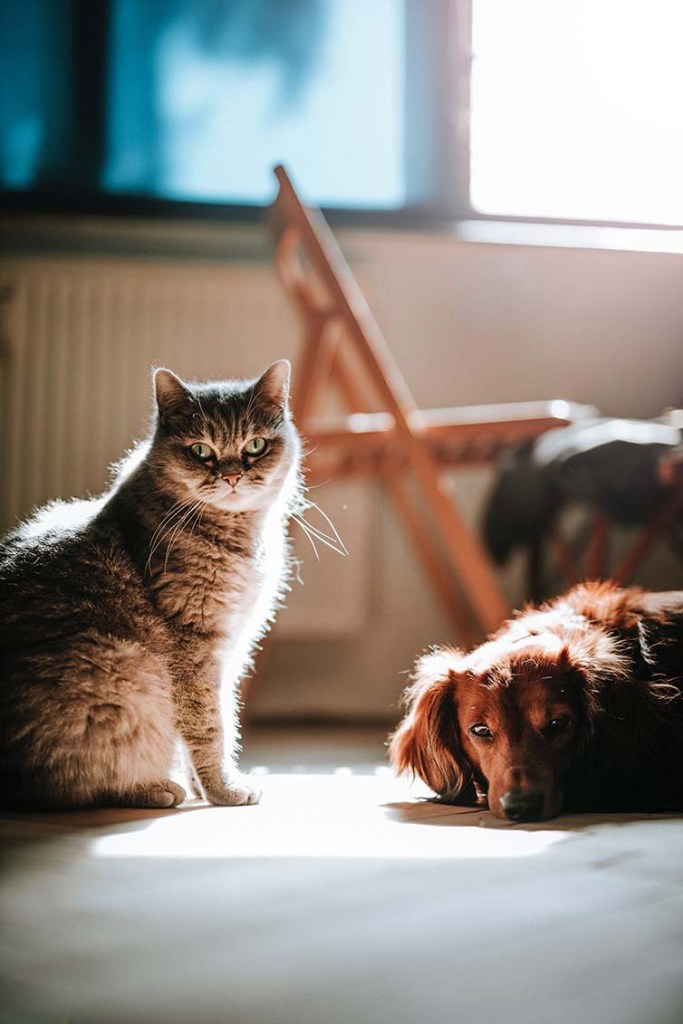
If you have a dog already, a good idea is to take them both for a couple of walks together, on neutral ground. You could even take your present furry child to meet his/her new brother/sister at the rescue centre, with their permission. Keep both dogs on leashes at all times. Once they are familiar with each other’s scents, they will probably (Sorry, but we can’t guarantee anything.) be fine together. Above all, KEEP CALM! Keep an eye on them and separate them if there are any signs of aggression. The ‘easiest’ combination is, of course, two of ‘opposite gender’. Two of the same gender, males or females, tend to fight for dominance. Don’t expect a beautiful friendship after a day or two; these things take time. Don’t force them to be together if they don’t want to be.
If you’re introducing a new canine to a resident feline, keep Cuddles in a separate room, if possible, for a day or two, and then introduce them carefully and without fuss. Keep Bruiser on a leash at all times during the introduction, and perhaps use a baby gate to keep them separate for a while.
Yes, there are stories and pictures on Facebook of lovely relationships between dogs and cats, but chances are, they’ll learn to tolerate each other after a while.
And finally…
Wherever your feline or canine friend comes from, we hope that you enjoy every minute together. Everyone in your family will benefit from the special relationship all of you will develop with your furry friend, especially if you have the knowledge that you have probably saved his/her life. On your new friend’s behalf, we thank you.
